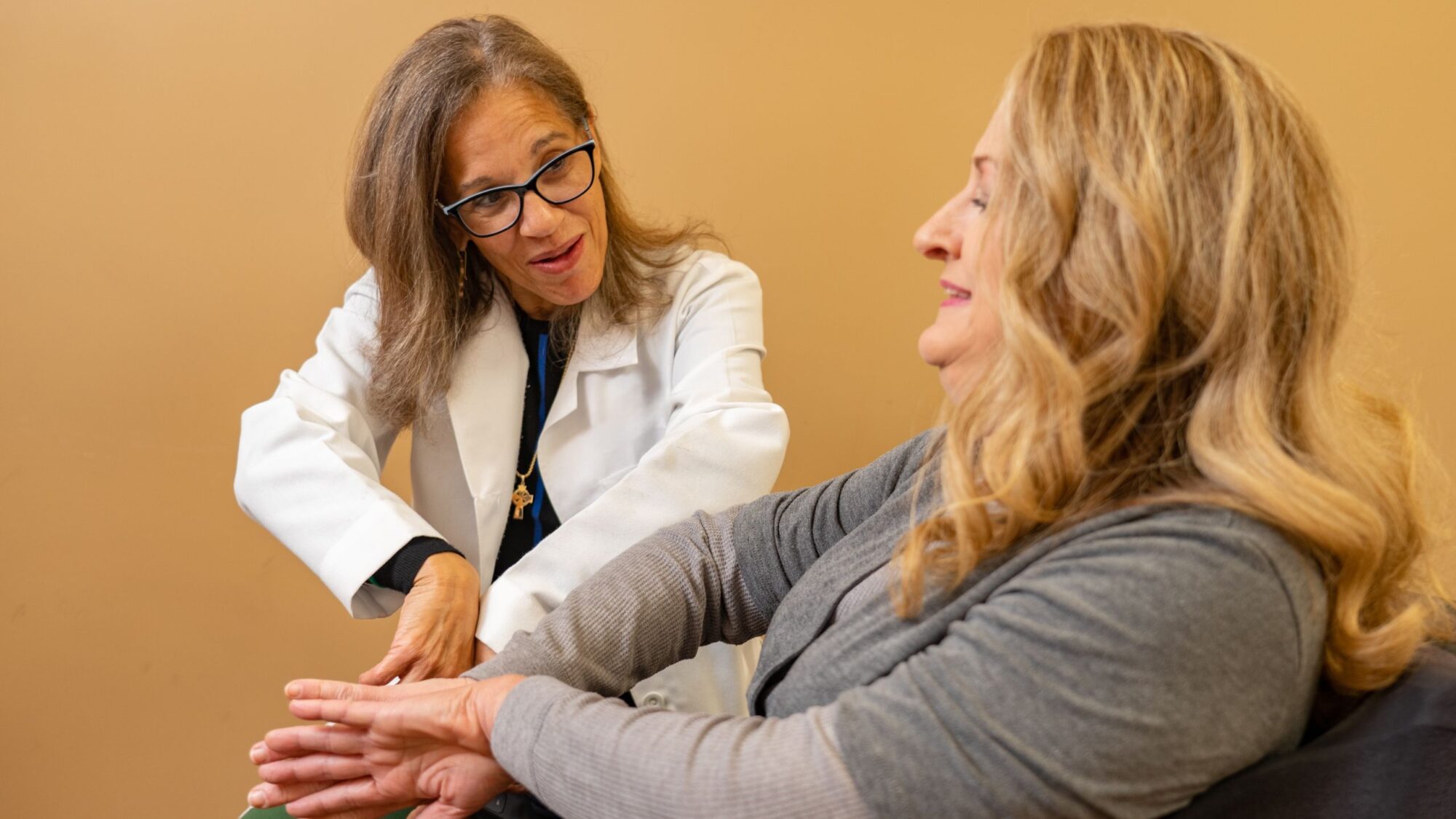
Neuro-Rehabilitation
At a Glance
- Neuro-rehabilitation is a process that helps people return to a new normal and regain as much function as possible after a brain or spinal cord injury or condition.
- Generally, it involves medical treatment, physical and cognitive therapy, and psychological support.
- Neuro-Rehabilitation is a continuum of hands-on care, starting at the bedside in the hospital, continuing through inpatient and outpatient rehabilitation, work and school re-entry programs, and robust support groups and community-based programs.
Overview
Neuro-rehabilitation is the process of helping people who have experienced brain and spinal cord injuries or conditions regain as much function as possible so that they can return to their normal, everyday lives.
It addresses the physical and neurological effects of an injury or condition—like pain, weakness, speech difficulties, or cognitive changes—through four anchors: medical treatment, physical therapy, cognitive therapy, and psychological support. The goal of neuro-rehabilitation is to reduce symptoms, restore function, and enhance overall quality of life by harnessing neuroplasticity, the brain’s ability to reorganize and form new connections.
By tapping into the power of neuroplasticity, neuro-rehabilitation teaches the brain to work differently, rather than simply restoring damaged cells. These therapies use repeated, meaningful, and goal-directed practice that prompts the brain to rewire itself and work around areas that have lost function.

Who is neuro-rehabilitation for?
Essentially, anyone with a neurological condition causing diminished movement, sensation, speech, or cognition can benefit from neuro-rehabilitation.
Neuro-rehabilitation is used to treat people who have suffered from a neurological injury or condition, including:
- Blood vessel disorders in the brain or spinal cord, like aneurysms, arteriovenous malformations (AVM), and dural arteriovenous fistulae
- Brain injury, such as traumatic brain injury (TBI) or anoxic injury
- Benign and cancerous brain tumors
- Degenerative disorders that worsen over time, like Parkinson’s disease, multiple sclerosis (MS), amyotrophic lateral sclerosis (ALS), and Alzheimer’s disease
- Stroke disorders, like ischemic stroke, hemorrhagic stroke, and transient ischemic attacks (TIA)
- Functional disorders, including headache, seizure disorder, dizziness, balance disorders, and occipital or trigeminal neuralgia
- Movement disorders, such as essential tremor and dyskinesia
- Neuromuscular disorders, like peripheral neuropathy, muscular dystrophy, Bell’s palsy, cervical spondylosis, and Guillain-Barré syndrome
- Infections like encephalitis, meningitis, and polio
The Barrow Difference
At Barrow Neurological Institute, our Neuro-Rehabilitation Center is one of the leading clinics for brain injury rehabilitation in the Southwest. In fact, U.S. News and World Report named us one of the nation’s Best Hospitals for Rehabilitation in 2025-2026.
Our highly skilled neuro-rehabilitation team is committed to helping you or your loved one return to life with a renewed sense of self-esteem and newfound independence—no matter what. Our extensive range of care, including inpatient and outpatient rehabilitation, work and school re-entry programs, support groups, and the latest neuro-rehabilitation technology, means we’re steadfast in our commitment to maximizing your quality of life.
Types of Neuro-Rehabilitation
In neuro-rehabilitation, therapies are interconnected and often combined, depending on a person’s specific needs. They can include:
- Physical therapy (PT): This approach helps restore movement, strength, balance, and coordination through exercises, mobility training, and the use of assistive devices.
- Occupational therapy (OT): Here, independence is regained through practicing daily tasks like getting dressed, eating, and writing. Occupational therapy often includes adaptations for the home and workplace.
- Speech and language therapy (SLP): In this therapy, the ability to communicate, comprehend, and swallow is emphasized after neurological injury.
- Cognitive rehabilitation: This therapy targets deficits in memory, attention, problem-solving, and executive function through structured exercises and the use of compensatory strategies.
- Neuropsychological therapy: This approach focuses on the emotional and behavioral changes that can follow a brain or spinal cord injury or condition, including depression, anxiety, and challenges adjusting to a new and different way of moving throughout the world. Neuropsychological testing can also help you a cognitive baseline to measure improvement against as you move through therapy.
- Vocational rehabilitation: This type of therapy helps individuals adapt day-to-day tasks and environments according to abilities, in order to return to work or school.
- Social and community reintegration: This therapy helps prepare patients for independent living, social interaction, and community participation.
The Neuro-Rehabilitation Continuum
Neuro-rehabilitation is a continuum—a series of progressive steps that guide recovery from hospital to home.
- Acute Hospital Care: Focused on saving lives and stabilizing medical conditions after neurological injury.
- Inpatient Neuro-Rehabilitation: Intensive, hospital-based setting with daily therapy and medical support.
- Outpatient Neuro-Rehabilitation: The next step once patients are medically stable and able to live at home but still require ongoing therapy.
- Community and Wellness Programs: Maintenance and long-term health support after completing outpatient rehab.
The outpatient program at Barrow bridges the gap between hospital and home, helping patients safely reintegrate into daily life while maintaining progress and access to specialized neurological care.
Inpatient Neuro-Rehabilitation
At Barrow Neurological Institute, our neuro-rehabilitative services offer unparalleled care for those with a traumatic brain injury (TBI) or spinal cord injury. Here, patients receive inpatient therapy in an acute setting, including a secure section for patients who may require careful observation. Therapy services are provided up to seven days a week, for an average of three hours per day, Monday through Friday, so that each patient can demonstrate progress toward meeting discharge goals.

Outpatient Neuro-Rehabilitation
Once patients have been discharged from an inpatient setting, they may be referred to one of our outpatient rehabilitation programs for ongoing treatment.
Outpatient neuro-rehabilitation programs at Barrow can include:
- Outpatient Neurological Rehabilitation Program: This program, accredited by the Commission on Accreditation of Rehabilitation Facilities (CARF), offers individualized treatment plans, flexible therapy scheduling, and a coordinated team approach to rehabilitation.
- Center for Transitional Neuro-Rehabilitation (CTN): This is an intensive day program designed to help individuals aged 14 and older who have experienced a brain injury develop the skills necessary to transition into school, work, or the community.
A Complete Team
The support of a multidisciplinary team is key to the neuro-rehabilitation process and can include neurologists, rehabilitation physicians (physiatrists), physical therapists, occupational therapists, speech-language pathologists, neuropsychologists, and psychiatrists. It also requires an active partnership with a range of health and social service professionals, like social workers, case managers, vocational counselors, and registered dieticians.
That said, an active involvement on the part of you and your supporters is essential to the success of neuro-rehabilitation.
Common Questions
Am I a good candidate for neuro-rehabilitation?
If you’re experiencing difficulty with speech, movement, vision, balance, or one of the many other lingering complications of a brain or spinal cord injury or condition, you can likely benefit.
It’s a common misconception that neuro-rehabilitation needs to happen immediately to be effective. In fact, it’s never too late to start a neuro-rehabilitation program. Many individuals can regain significant function and benefits months or even years after their initial diagnosis or injury, when coupled with a personal commitment to the appropriate neuro-rehabilitation therapies.
What kind of outcomes can I expect after neuro-rehabilitation?
As a whole, neuro-rehabilitation tends to improve functional outcomes in mobility and ability to do daily tasks, enhance social or vocational participation, and improve overall survival rates when compared to no or minimal rehabilitation. With neuro-rehabilitation, your chances of a more robust recovery, returning home or back to work, and participating in everyday society are improved compared to those who do not.
That said, the degree of improvement depends heavily on the individual and their treatment factors. Neuro-rehabilitation should be viewed as a key component of recovery, rather than a guarantee of complete restoration.
Resources
American Academy of Physical Medicine and Rehabilitation
American Spinal Injury Association




